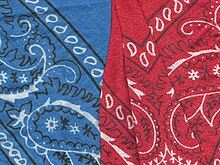Handkerchief: Difference between revisions
Undid revision 465885191 by 75.99.99.82 (talk) |
No edit summary |
||
| Line 23: | Line 23: | ||
==Folding styles== |
==Folding styles== |
||
[[Image:Grey and navy suit on mannequin.jpg|thumb|Suits with pocket squares]] |
[[Image:Grey and navy suit on mannequin.jpg|thumb|Suits with pocket squares]] |
||
When used as an accessory to a [[suit (clothes)|suit]], a handkerchief is known as a '''pocket square'''. There are a wide variety of ways to fold a pocket square, ranging from the austere to the flamboyant:[[File:Men in Suits.jpg|thumb|Men in Suits with |
When used as an accessory to a [[suit (clothes)|suit]], a handkerchief is known as a '''pocket square'''. There are a wide variety of ways to fold a pocket square, ranging from the austere to the flamboyant:[[File:Men in Suits.jpg|thumb|Men in Suits with handkerchiefs]] |
||
*The Presidential, perhaps the simplest, is folded at right angles to fit in the pocket. |
*The Presidential, perhaps the simplest, is folded at right angles to fit in the pocket. |
||
Revision as of 14:46, 19 December 2011
This article needs additional citations for verification. (January 2011) |

A handkerchief (pronounced /ˈhæŋkərtʃɪf/), also called a handkercher or hanky, is a form of a kerchief, typically a hemmed square of thin fabric that can be carried in the pocket or purse, and which is intended for personal hygiene purposes such as wiping one's hands or face, or blowing one's nose. A handkerchief is also sometimes used as a purely decorative accessory in a suit pocket.
The material of a handkerchief can be symbolic of the social-economic class of the user, not only because some materials are more expensive, but because some materials are more absorbent and practical for those who use a handkerchief for more than style. Handkerchiefs can be made of cotton, cotton-synthetic blend, synthetic fabric, silk, or linen.
Handkerchiefs were also used, especially by children, as an impromptu way to carry around small items when a bag or basket was unavailable. They could also serve as a substitute for a bandage over a small injury. In the United Kingdom, the habit of wearing a handkerchief with tied corners on one's head at the beach has become a seaside postcard stereotype, referenced by the Gumby characters in Monty Python's Flying Circus.
King Richard II of England, who reigned from 1377 to 1399, is widely believed to have invented the cloth handkerchief, as surviving documents written by his courtiers describe his use of square pieces of cloth to wipe his nose. Certainly they were in existence by Shakespeare's time, and a handkerchief is an important plot device in his play Othello.
Modern usage

The use of a cloth handkerchief is occasionally considered old-fashioned or unhygienic, or both, in some parts of the world, mainly due to the popularization of disposable paper handkerchiefs and the fact that they are stored in a pocket or a purse after being used. However they are a potentially more environment-conscious choice, as cloth handkerchiefs are reusable.
At first the Kleenex company had not imagined that there would be a demand for a disposable paper handkerchief, so they initially marketed their product exclusively for make-up removal. It was only after they discovered that people were blowing their nose into the tissues that they began marketing them for this purpose.[1]
Handkerchiefs are also used to hold hair back, as a fashionable head accessory. Handkerchiefs designed for this purpose are usually printed in a vibrant color and with a paisley pattern, and are known as bandanas or kerchiefs.
Signals may also be sent by handkerchief, such as the American LGBT handkerchief codes. In Spanish football or in bullfighting, it is a common sight to see supporters waving white handkerchiefs as an expression of deep emotion. It is used both positive in admiration of an exceptional performance by their team or a particular player (even an opposition player as was experienced by Ronaldinho during a victory for FC Barcelona over Real Madrid at the Santiago Bernabéu Stadium, in which Madrid fans openly applauded his performance), or as a negative sign of disgust at an especially bad performance by their team.
Folding styles

When used as an accessory to a suit, a handkerchief is known as a pocket square. There are a wide variety of ways to fold a pocket square, ranging from the austere to the flamboyant:

- The Presidential, perhaps the simplest, is folded at right angles to fit in the pocket.
- The TV Fold looks similar but is folded diagonally with the point inside the pocket.
- The One-point Fold is folded diagonally with the point showing.
- The Two-point Fold is folded off-center so the two points do not completely overlap.
- The Three-point Fold is first folded into a triangle, then the corners are folded up and across to make three points.
- The Four-point Fold is an off-center version of the Three-point Fold.
- The Cagney is basically a backwards version of the Four-point Fold.
- The Puff or the Cooper is simply shaped into a round puff.
- The Reverse Puff is like the Puff, except with the puff inside and the points out, like petals.
- The Astaire is a puff with a point on either side.
- The Straight Shell is pleated and then folded over to give the appearance of nested shells.
- The Diagonal Shell is pleated diagonally and then folded.
Designer Michele Rondini developed the "Poshfit", a pocket square with jewellery chain attached to a buttonhole of the blazer.
See also
References
- ^ Kleenex (2007-03-08). "Kleenex History". Retrieved 2007-03-08.
{{cite web}}: Cite has empty unknown parameter:|coauthors=(help)
